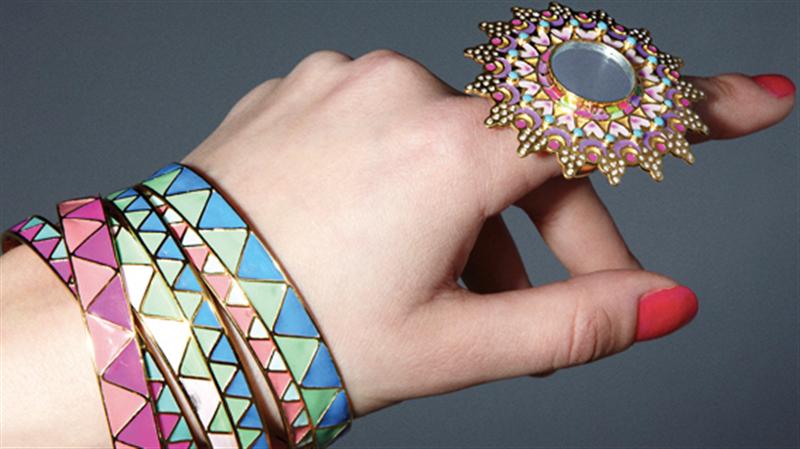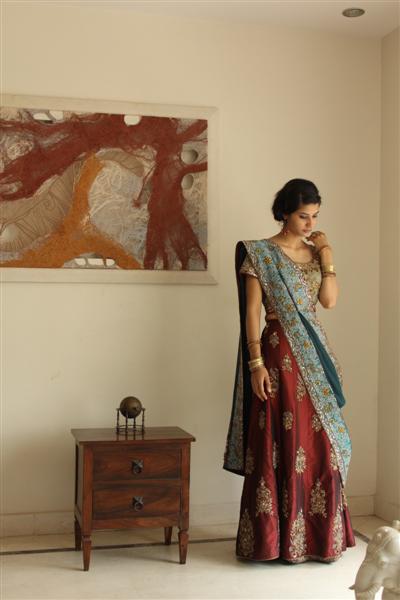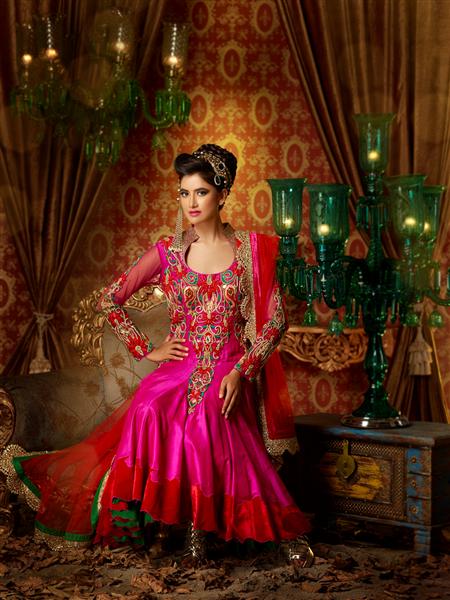India celebrates heritage fashion
With heritage of India expressed in contemporary flavor, fashion designers have unveiled a trend which is not only colourful; it is stylish and gives an exotic look and a new meaning to fashion.
Ritu Ghai from Delhi asks you to explore your design sense and wear a little colour yourself.
Style cues from Designers
The trends are as traditional as our heritage and the designs are as contemporary as the era we live in. This season there is a riot of floor length anarkalis all around. The modern version of this traditional Mughal dress became an instant rage when Bollywood divas like Madhuri Dixit, Aishwariya Rai, Bachchan, Sonakshi Sinha were seen sporting them at various function. Designed for them by ace designers such a Manish Malhotra, Abu Sandeep and Rina Dhaka, these full length anarkalis have caught the fancy of women like never before. Almost grazing the floor with the churidaar completely hidden underneath, this style has taken this Mughal dress to a whole new level.
Famous designer duo, RAHUL & GUNJAN, have a line of collection that is inspired by the traditional crafts and the vibrant colors of India. It celebrates the spirit of the festival season and lends a special touch to wedding trousseau. Their garments make you think a little out-of-the-box with unconventional colors and unusual and modern embroideries. Use of ingenious materials like fabric strips and hand cut metal sheets to embellish their designs. They give a whole new meaning to how fashion is going to be followed in the coming time.
Fashion designer Manish Arora, who has recently unveiled the collection, “India Enchanted ” incollaboration with leading jewellery brand Amrapali, says, “The magnificence of India’s culture is represented through the varied meanings associated with bright accent colors and it is represented by eclectic hand-drawn illustration resulting in intricate, visually striking graphic styles. Through this collection, Amrapali and I have put forth the splendid tradition of India with a contemporized flavor taking you deeper into the Indian heritage emphasizing on the everlasting beauty of nature and post culture exoticism. The collection is a revitalization of tradition; brings to life techniques and motifs of the animals, lotus, and leaves through the exquisite collections of contemporary jewelry with a little essence of traditional converge.”
Notable designers, Mansi and Vishal Arora evoke grandeur and style with their latest collection that is ultra feminine and juxtaposed with futuristic silhouettes. “We are inspired by the serene yet royal beauty and feminism of the Victorian and Mughal heritage period in the fashion history. In our latest collection, we have focussed on embellished lehengas and colourful Anarkalis, along with ornate ballroom gowns which have voluminous bottoms and structured tops,” says Vishal and agrees Mansi.
And if fashion is all about trends then how can jewellery be left behind? Worn more out of passion, these trendy items, not only complete your wear but accentuates it and lends it a distinct character. Timeless and undated in appeal, there are million reasons to wear them and a billion to choose from.
To further perk up your traditional wear is the royal Indian footwear – Mojris which are comfortably paired with denims and kurtis. Beautifully handcrafted and ornately designed with colored threads, beads and fabrics, these are made of fine leather and skillfully handcrafted with embroidered threads. Cradle your feet in the lap of comfort with multi-colored wedges complete with funky beads and a perky ankle strap. After all you ought to look in the festive mood, from tip to top.
Undated fashion
Indian fashion, however contemporary, cannot be separated from its ancient lineage. This very treasure of traditional crafts has put India on the designer map of the world. From the zardozi of the Mughal era to the intricate ”˜kantha’ stitch of Bengal, India boasts of a rich tradition of embroidery. The geometric phulkari of Punjab, mirror works motifs of Kutch, Kashmir’s stylized plant and floral motifs, tone-on-tone Chikan of Lucknow and Kanthas of Bengal – all form part of the vast repertoire of India’s embroidery traditions. Block printing is another highly developed tradition of ornamenting textiles where small surfaces of wood carved in reverse are dipped into dyes and the design is transferred on to cloth.
Right from the riyasati karkhanas to the factories of the famous designers, embroideries have graced the fabrics and lend them elegance, culture and beauty. But whether it’s Kutch embroidery mirror work or Parsi gara embroidery or the pristine chiaroscuro of chikankari – all are a manifestation of the creativity of workers and the dexterity of their hands.
Several craftsmen toil for long hours to give us this fine art of embroidery. Long working hours, low wages and a wide gap between the chikankar and the market pose a threat to the popularity of this art form. But organizations like SEWA (self employed women organization) and Dastkar have committed themselves to changing the life of thousands of women, giving them their dues and lending these traditional embroideries an up-market high profile image. They have proved that craft is a viable tool for employment and income generation.
Popular designers have patronized these rich forms of embroidery and creatively apply them on their designs to not only place them on the celebrity buying list but give them a global presence.
Plenty of designers have revived the chikan-kari work that was once patronized by Empress Noorjehan who made this fine-as-a-gossamer-thread pattern, into a court fashion.
Mahatma Gandhi also promoted chikan when he awarded a chikan worker in 1948. Since then chikan craftsmen are rewarded annually. In 1969, the first chikan craftsman, Hasan Mirza, was honoured for his unique work in which needle was not penetrated in the fabric but only a stitch made so that no thread was made on the other side.
Veteran designer, Ritu Kumar is known to go deep into the roots of every design and find its relevance in the present context. She began research and work on reviving the forgotten art of Zardozi from a small village of Ranihati, few miles outside Kolkata. In 1985, after years of research, innovation and creation, she launched her Zardozi collection in New Delhi, the first ever display of Zardozi in a contemporary era. Because of her, Zardozi is now an extensively used and widely appreciated technique around the country.
She also developed ”˜Kashida’ as the art of colored thread embroidery on hand block printed fabric and showcased the same in her collection in 1988.
She has brought forth myriad permutations on the Ambi, or what is known as the paisley to the rest of the world, hidden amidst the valleys of Kashmir. Buti from the desert reaches of Rajasthan and dusty plains of Gujarat, spring-like textured jalis in the ateliers of Farukhabad School from the Indian heartland and the prints of stylized flowers, leaves, birds, trees, vines from Karabagh regions of southwestern shores of India, stretching from Macchalipatnam to Negapatnam on the Cholamandal Coast.
Painted and printed tradition of Kalamkari to the soft appeal of the finest Murshidabad silk, Ritu Kumar has brought in a fresh energy to the eternal Indian identity of design. Her Sangmarmar Collection pays tribute to the pristine white of the immortal Taj Mahal. Comprising of outfits in soft white tery-rubia, with ”˜tone-on-tone’ white embroidery or delicate pastel contrasts, this collection epitomizes the purity of marble.
So with the most coveted styles and designers to choose from, start working towards your celebration plans and finishing off in-style.
Short URL: https://indiandownunder.com.au/?p=2048



